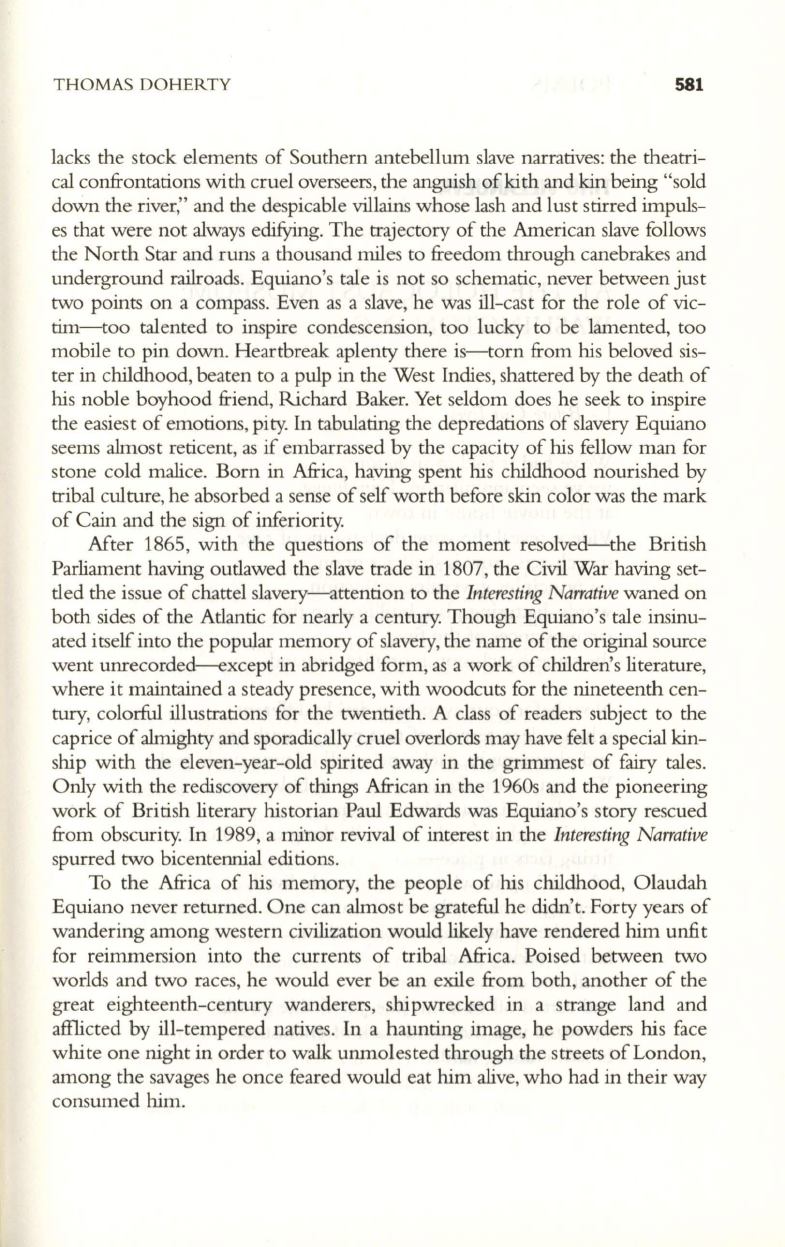
THOMAS DOHERTY
581
lacks the stock elements of Southern antebellum slave narratives: the theatri–
cal confrontations with cruel overseers, the anguish of kith and
kin
being "sold
down the river;' and the despicable villains whose lash and lust stirred impuls–
es that were not always edifying. The trajectory of the American slave follows
the North Star and runs a thousand miles to freedom through canebrakes and
underground railroads. Equiano's tale is not so schematic, never between just
two points on a compass. Even as a slave, he was ill-cast for the role of vic–
tim-too talented to inspire condescension, too lucky to be lamented, too
mobile to pin down. Heartbreak aplenty there is-torn from his beloved sis–
ter in childhood, beaten to a pulp in the West Indies, shattered by the death of
his noble boyhood friend, Richard Baker. Yet seldom does he seek to inspire
the easiest of emotions, pity.
In
tabulating the depredations of slavery Equiano
seems almost reticent, as
if
embarrassed by the capacity of his fellow man for
stone cold malice. Born in Africa, having spent his childhood nourished by
tribal culture, he absorbed a sense of self worth before skin color was the mark
of Cain and the sign of inferiority.
Mter 1865, with the questions of the moment resolved-the British
Parliament having outlawed the slave trade in 1807, the Civil War having set–
tled the issue of chattel slavery-attention to the
Interesting Narrative
waned on
both sides of the Atlantic for nearly a century. Though Equiano's tale insinu–
ated itself into the popular memory of slavery, the name of the original source
went unrecorded---except in abridged form, as a work of children's literature,
where it maintained a steady presence, with woodcuts for the nineteenth cen–
tury,
colorful illustrations for the twentieth. A class of readers subject to the
caprice of almighty and sporadically cruel overlords may have felt a special kin–
ship with the eleven-year-old spirited away in the grimmest of fairy tales.
Only with the rediscovery of things African in the 1960s and the pioneering
work of British literary historian Paul Edwards was Equiano's story rescued
from obscurity.
In
1989, a mihor revival of interest in the
Interesting Narrative
spurred two bicentennial editions.
To the Africa of his memory, the people of his childhood, Olaudah
Equiano never returned. One can almost be grateful he didn't. Forty years of
wandering among western civilization would likely have rendered
him
unfit
for reimmersion into the currents of tribal Africa. Poised between two
worlds and two races, he would ever be an exile from both, another of the
great eighteenth-century wanderers, shipwrecked in a strange land and
afflicted by ill-tempered natives.
In
a haunting image, he powders his face
white one night in order to walk unmolested through the streets of London,
among the savages he once feared would eat
him
alive, who had in their way
consumed him.


